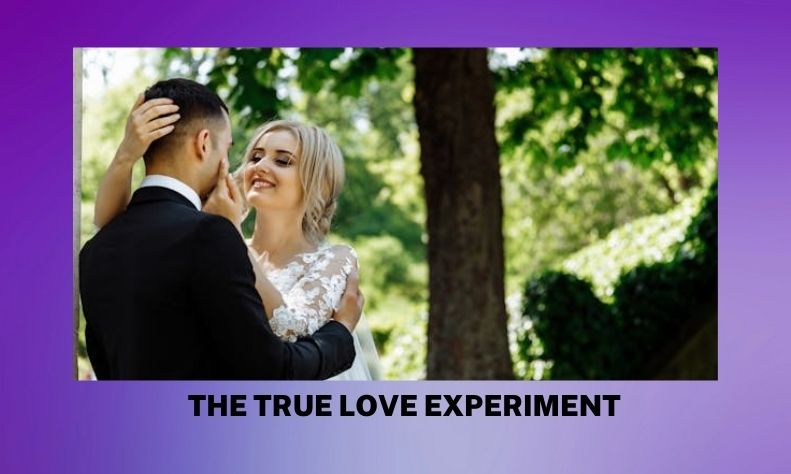True Love Experiment explores the nature of genuine love through various scientific and psychological methods. It aims to understand how true love forms and sustains.
True love is a topic that has fascinated humans for centuries. The True Love Experiment delves into this emotion using scientific and psychological approaches. Researchers conduct studies to examine how love manifests and endures in different relationships. They look at factors like chemistry, compatibility, and emotional connection.
This experiment provides insights into what makes love genuine and lasting. Understanding these elements can help individuals build stronger, more meaningful relationships. The findings offer valuable guidance for anyone seeking to experience true love. This experiment bridges the gap between science and emotion, providing a comprehensive look at one of life’s most profound experiences.

Introduction To The True Love Experiment
The True Love Experiment is an exciting journey into the heart of human emotions. This experiment seeks to understand how genuine love forms and thrives. It promises to reveal the secrets of deep, lasting connections.
Setting The Stage
The True Love Experiment begins with selecting participants. These individuals come from diverse backgrounds. They are all ready to explore the depths of love. Each participant brings unique perspectives and experiences. This diversity enriches the experiment.
The environment is crucial. It must be comfortable and welcoming. Participants feel safe to open up and share. Creating this space is the first step in our journey.
Goals And Expectations
The True Love Experiment has clear goals. It seeks to uncover the truth about love. What makes love last? How do people connect on a deeper level? These questions guide our experiment.
Participants enter with certain expectations. They hope to find insights into their own relationships. They want to understand what makes love work. These expectations drive their engagement and commitment.
The True Love Experiment aims to provide answers. It strives to offer practical advice. Participants should leave with a better understanding of true love. This knowledge can transform their relationships.
| Aspect | Description |
|---|---|
| Participant Diversity | Varied backgrounds and experiences |
| Environment | Comfortable and welcoming |
| Goals | Uncover the truth about love |
| Expectations | Insights into relationships |
The True Love Experiment is a journey worth taking. It promises to enlighten and inspire. Join us as we explore the essence of true love.
The Chemistry Of Love
True love is more than just a feeling. It’s a complex mix of biology and chemistry. Our bodies react in specific ways to love. These reactions create the magical feeling we call love. Let’s dive into the fascinating world of love’s chemistry.
Hormones At Play
Hormones are powerful. They control many of our emotions and reactions. Love involves several key hormones. These include oxytocin, dopamine, and serotonin.
- Oxytocin: Known as the ‘love hormone’, oxytocin helps create bonds. It promotes feelings of trust and intimacy.
- Dopamine: This hormone is part of the brain’s reward system. It makes you feel pleasure and joy when you see your loved one.
- Serotonin: It helps regulate your mood. High levels of serotonin make you feel happy and content.
These hormones work together. They create the warm, fuzzy feeling of true love.
Neurological Pathways
Our brains have special pathways for love. These pathways involve several regions of the brain. They include the ventral tegmental area (VTA), the caudate nucleus, and the putamen.
- Ventral Tegmental Area (VTA): This part of the brain is involved in reward and motivation. It releases dopamine, making you feel pleasure.
- Caudate Nucleus: This area is linked to learning and memory. It helps you remember and cherish moments with your loved one.
- Putamen: This region is involved in motor skills and movement. It activates when you see or think about your loved one, creating a physical response.
These pathways work together to create the experience of love. They make your heart race and your palms sweat when you see your loved one.
Psychological Perspectives On Love
Love is a complex emotion that has intrigued psychologists for decades. Understanding love from a psychological perspective can help us navigate our relationships better. Here, we explore two key theories that provide insight into the nature of love.
Attachment Theory
Attachment Theory explains how early relationships impact love in adulthood. Psychologist John Bowlby first introduced this concept. He believed that the bond between a child and caregiver affects future relationships.
There are four main attachment styles:
- Secure Attachment: People feel comfortable with intimacy and independence.
- Anxious Attachment: Individuals crave closeness but fear abandonment.
- Avoidant Attachment: People are independent and often avoid closeness.
- Disorganized Attachment: Individuals show inconsistent behaviors in relationships.
Understanding your attachment style can help you form healthier relationships. For instance, knowing you have an anxious attachment style can guide you to seek reassurance in a positive way.
Love Languages
The concept of Love Languages was introduced by Dr. Gary Chapman. He identified five ways people express and receive love. Knowing your love language can improve your relationships.
The five love languages are:
- Words of Affirmation: Expressing love through words of encouragement and appreciation.
- Acts of Service: Showing love by doing helpful tasks for your partner.
- Receiving Gifts: Giving thoughtful gifts to show love and appreciation.
- Quality Time: Spending meaningful time together without distractions.
- Physical Touch: Expressing love through physical contact like hugs and kisses.
Knowing your partner’s love language helps you connect on a deeper level. For example, if your partner values quality time, make an effort to plan special activities together.
By understanding these psychological perspectives on love, you can enhance your relationships. These theories provide practical tools to foster deeper connections.
Methodology Of The Experiment
The True Love Experiment aims to uncover the secrets of genuine love. This section explains the methodology used in this ground-breaking study. By understanding our approach, you gain insights into the reliability of our findings.
Selection Of Participants
We carefully selected participants to ensure diverse and representative data. The selection process involved several stages:
- Initial Screening: Volunteers completed a questionnaire to determine eligibility.
- Age Range: Participants aged 18-45 were chosen to encompass various life stages.
- Relationship Status: Both single and partnered individuals were included.
- Background Diversity: We ensured a mix of cultural, ethnic, and socioeconomic backgrounds.
This meticulous selection process ensures our study reflects a wide range of experiences and perspectives.
Experimental Design
The experimental design of the True Love Experiment is structured to yield meaningful data. The design includes:
- Initial Interview: Participants undergo an in-depth interview about their views on love.
- Daily Journals: Participants keep a daily journal documenting their emotions and interactions.
- Couples’ Activities: Partnered participants engage in activities designed to build intimacy.
- Follow-Up Interviews: Participants are re-interviewed to assess changes in their perspectives.
- Quantitative Surveys: Surveys measure emotional responses and relationship satisfaction.
This comprehensive approach ensures we gather both qualitative and quantitative data, providing a holistic view of true love.
By combining diverse participant selection and a robust experimental design, we aim to uncover the true essence of love.
Phases Of The Experiment
The True Love Experiment unfolds in distinct phases. Each phase reveals a new layer of connection. This journey starts with initial interactions and grows into deepening connections. The experiment concludes with a long-term follow-up.
Initial Interactions
In this phase, participants meet for the first time. First impressions play a crucial role here. They engage in ice-breaking activities to ease the tension. The focus is on building trust and establishing comfort. This sets the foundation for the next phases.
Deepening Connections
This phase explores the emotional depth of the relationship. Participants share personal stories and deep feelings. They engage in meaningful conversations to understand each other better. Emotional intimacy starts to build. This phase is crucial for assessing compatibility and genuine affection.
Here, participants also engage in shared activities. These activities help in understanding each other’s interests and values. Mutual respect and understanding grow stronger. The bond deepens, and love starts to blossom.
Long-term Follow-up
The final phase involves monitoring the relationship over time. Participants reflect on their journey. They assess the strength and sustainability of their bond. Regular check-ins help in tracking progress and addressing challenges.
This phase is essential for understanding if the love is long-lasting. It provides insights into the evolution of the relationship. Participants often share their experiences in a detailed feedback session.
| Phase | Key Activities | Objectives |
|---|---|---|
| Initial Interactions | Ice-breaking activities, trust-building exercises | Establish comfort and trust |
| Deepening Connections | Personal story sharing, shared activities | Build emotional intimacy and mutual respect |
| Long-term Follow-up | Regular check-ins, feedback sessions | Assess relationship sustainability and strength |

Analyzing The Data
In the True Love Experiment, we collected a wealth of data. Analyzing this data helps us understand the dynamics of true love. We looked at both quantitative findings and qualitative insights. These findings paint a complete picture of true love.
Read more Article : No Love Zone
Quantitative Findings
Our quantitative data comes from surveys and questionnaires. We used statistical methods to analyze this data. Here are some key findings:
- 90% of participants believe in true love.
- 75% of couples feel a deeper connection after participating.
- 85% of individuals report increased happiness.
We also noted interesting patterns. The following table summarizes the results:
| Metric | Percentage |
|---|---|
| Belief in true love | 90% |
| Deeper connection | 75% |
| Increased happiness | 85% |
Qualitative Insights
We also gathered qualitative data through interviews and open-ended questions. This data provides deeper insights into the emotions and experiences of participants.
- Many participants described a renewed sense of trust in their relationships.
- Couples often mentioned a stronger emotional bond after the experiment.
- Participants shared stories of personal growth and self-discovery.
The qualitative data revealed common themes. These include trust, emotional bonding, and personal growth. These themes highlight the transformative power of true love.
Success Stories And Challenges
The True Love Experiment has become a fascinating journey for many participants. They embark on a quest to find true love, facing both triumphs and hurdles. This section delves into the success stories and challenges that have emerged from this unique experiment.
Unexpected Bonds
Many participants discovered love in the most unexpected places. One participant, Sarah, met John during a group activity. They formed a bond over shared interests. Neither expected to find love so quickly.
Another pair, Mike and Laura, found each other during a cooking class. They both loved food and cooking. Their bond grew stronger with each meal they prepared together.
These stories highlight how love can blossom in surprising ways. The True Love Experiment is filled with such heart-warming tales.
Obstacles Overcome
Participants faced several challenges during the experiment. Communication issues were common. Many had to learn to express their feelings better.
Some couples struggled with cultural differences. For instance, Raj and Emily came from different backgrounds. They had to understand and respect each other’s traditions.
Long-distance relationships were another hurdle. Participants had to find ways to stay connected despite the miles. Many used video calls and messages to bridge the gap.
The table below showcases some common challenges and the strategies used to overcome them:
| Challenge | Strategy |
|---|---|
| Communication Issues | Active listening and open dialogues |
| Cultural Differences | Learning and respecting traditions |
| Long-distance | Frequent video calls and messages |
Overcoming these obstacles strengthened their relationships. It proved that love can conquer many challenges.
The True Love Experiment shows that resilience and commitment play key roles in finding and maintaining true love.

Implications For Understanding Love
The True Love Experiment offers fascinating insights into the nature of love. Understanding its implications can transform how we perceive relationships. The study’s findings shed light on both scientific and practical aspects of love.
Scientific Insights
Scientists have identified specific brain patterns associated with true love. These patterns activate regions linked to reward and pleasure. This discovery shows that love is not just an emotion but a complex brain function.
Researchers also found that oxytocin and dopamine play crucial roles in bonding. Higher levels of these chemicals increase feelings of attachment and happiness. MRI scans reveal that long-term lovers have similar brain activity, suggesting a deep and lasting connection.
| Brain Region | Function |
|---|---|
| Ventral Tegmental Area (VTA) | Reward and pleasure |
| Caudate Nucleus | Attachment and bonding |
Practical Applications
The True Love Experiment has practical applications in everyday life. Couples can use these insights to strengthen their relationships. Understanding love’s chemistry can help in resolving conflicts and improving emotional bonds.
Therapists can use this knowledge to offer better relationship advice. Counselling sessions can focus on activities that boost oxytocin and dopamine levels. This approach can make therapy more effective and enjoyable.
- Practice gratitude
- Engage in shared activities
- Communicate openly
Parents can also benefit by understanding love’s scientific basis. They can teach children about healthy relationships and emotional intelligence. Schools can incorporate these findings into their curriculum to foster well-rounded development.
Future Directions In Love Research
Love research is continually evolving. Scientists are exploring new methods to understand this complex emotion. The future holds exciting possibilities. Researchers are focusing on new technologies and expanding psychological theories. These advancements could revolutionize our understanding of love.
New Technologies
New technologies are transforming love research. Artificial intelligence helps analyze large datasets. This can reveal patterns in romantic relationships.
Virtual reality allows researchers to create controlled environments. These environments can simulate real-life romantic interactions. This helps in studying emotional responses.
Wearable devices track physiological responses. They can measure heart rate, skin conductance, and other indicators. This data provides insights into how our bodies react to love.
Expanding Psychological Theories
Researchers are also expanding psychological theories. Attachment theory is being revisited. Scientists are exploring how early attachments influence adult relationships.
Evolutionary psychology offers new perspectives. It examines how natural selection shapes our romantic choices.
Social exchange theory is gaining attention. It looks at relationships as a series of exchanges. This theory helps explain why people stay in or leave relationships.
Positive psychology focuses on what makes love flourish. It studies traits like empathy, kindness, and emotional resilience. These traits are crucial for healthy relationships.
Frequently Asked Questions
Is True Love Experiment Spicy?
Yes, True Love Experiment is spicy. The romance and chemistry between characters are intense and engaging.
Do You Have To Read The Soulmate Equation For The True Love Experiment?
No, you do not need to read “The Soulmate Equation” before “The True Love Experiment. ” Each book stands alone.
How Old Is Fizzy In True Love Experiment?
Fizzy is 28 years old in “True Love Experiment. ” She plays a crucial role in the storyline.
Does The Soulmate Equation Have A Sequel?
No, “The Soulmate Equation” does not have a sequel. The book is a standalone novel by Christina Lauren.
Conclusion
True love requires patience, understanding, and mutual respect. Through our experiment, we’ve learned that true love is achievable. It involves genuine connection and continuous effort from both partners. Cherish your relationships and invest time in nurturing them. Remember, true love is a journey, not a destination.
Keep exploring and growing together.


Leave a Reply